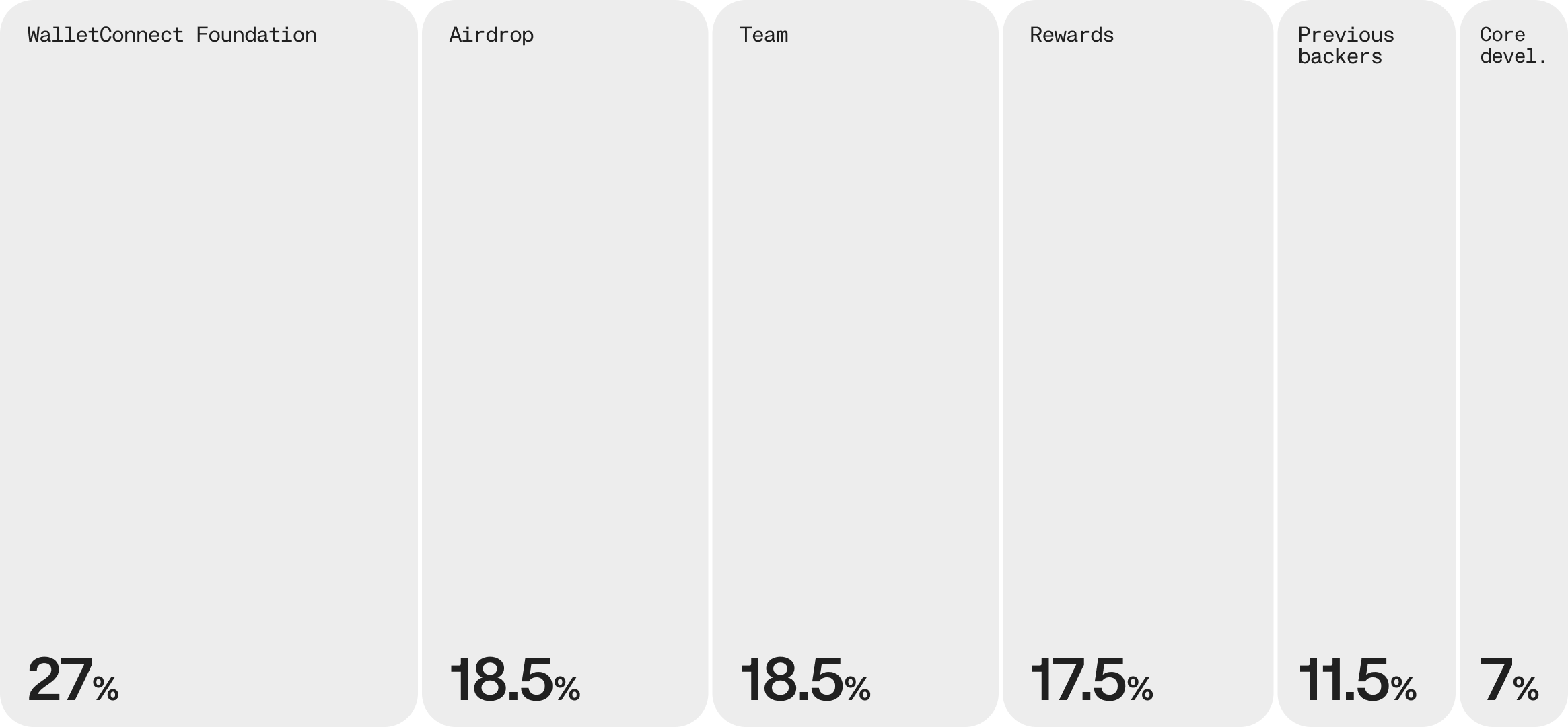Token Functions
The WCT token has four primary functions within the WalletConnect Network:- Fees: At first the Network will not charge fees, but token holders will have the ability to vote on fees being charged for Network services such as relay usage and other future services.
- Rewards: WCT tokens are distributed as rewards to incentivize participation and contribute to Network security and efficiency.
- Staking: Participants can stake WCT tokens to earn rewards and participate in governance.
- Governance: WCT holders can vote on proposals and changes, giving the community control over the Network’s development through decentralized governance.
Token Transferability
Transferability Status Update
Starting Tuesday, April 15th, 2025, the WCT token will become fully transferable. This means that all WCT token holders will be able to transfer their tokens freely between wallets and addresses. This marks a significant milestone in the evolution of the WalletConnect Network, expanding the utility of the WCT token beyond governance and staking to include full transferability.What Changes with Transferability?
| Before April 15th | After April 15th |
|---|---|
| Non-transferable — tokens could not be sent to other wallets or exchanges | Fully transferable — tokens can be moved freely across wallets and platforms |
| Governance participation enabled | Governance participation remains enabled |
| Staking enabled | Staking remains enabled |
Why Was Transferability Initially Restricted?
When the WCT token launched, it was intentionally non-transferable. This early design choice supported several important goals during the initial rollout phase: 1. Ecosystem-First Approach Ensured that tokens remained within the WalletConnect ecosystem, allowing users to participate in governance and staking without external market dynamics interfering prematurely. 2. Focus on Stability and Security Protected the Network’s early infrastructure from risks associated with immediate liquidity, such as speculation-driven volatility. 3. Gradual, Community-Led Progression Enabled the WalletConnect community to engage deeply with the Network’s core functionality before introducing token mobility.How Transferability Was Enabled
True to the principles of decentralization, the transition to transferability was not unilateral. The process involved:- Community participation in governance discussions
- Alignment around key ecosystem readiness milestones
- A governance vote to approve the enabling of transferability
What’s Next for WCT Holders?
With transferability unlocked, WCT holders can:- Transfer tokens freely
- Continue participating in governance and staking
- Engage in a broader range of use cases as the ecosystem evolves
WCT Allocation

- WalletConnect Foundation: 27%
- Airdrops: 18.5%
- Team: 18.5%
- Rewards: 17.5%
- Previous Backers: 11.5%
- Core Development: 7%
Token Inflation
The initial design of the WalletConnect Network’s tokenomics does not include token inflation. The current model focuses on utilizing existing token allocations and the potential to introduce fee structures to support Network operations and incentivize participation such that inflation is not envisioned within the first 3-4 years. However, the Network’s governance structure and community retain the flexibility to implement inflation mechanisms in the future if deemed appropriate. Any decision to introduce inflation would be subject to careful consideration of Network metrics, participant feedback, and overall ecosystem health, with specific parameters to be determined through Network governance processes.Token Flow
Initially, applications and SDKs will not be charged fees by the Network for using the relay services. However, given there is a cost to provide this service in a privacy-preserving and censorship resistant way, it may be necessary, when the ecosystem reaches an appropriate stage of maturity, that the introduction of fees could be proposed by the community, discussed, and decided upon through governance. The simplified token flow within the WalletConnect Network follows these steps:- A user initiates a connection with an app.
- The user connects with the relay to establish the connection.
- Once the connection is established, the relay facilitates communication.
- Each message relayed has an associated price, which the app or SDK pays in fees.
- The collected fees are used to reward nodes and wallets for their work in maintaining the Network.
- This process repeats for all messages conveyed through the Network.
The mechanism for charging fees is intended to ensure that the end user does not have to pay to make a connection and has no other friction added to their user experience.